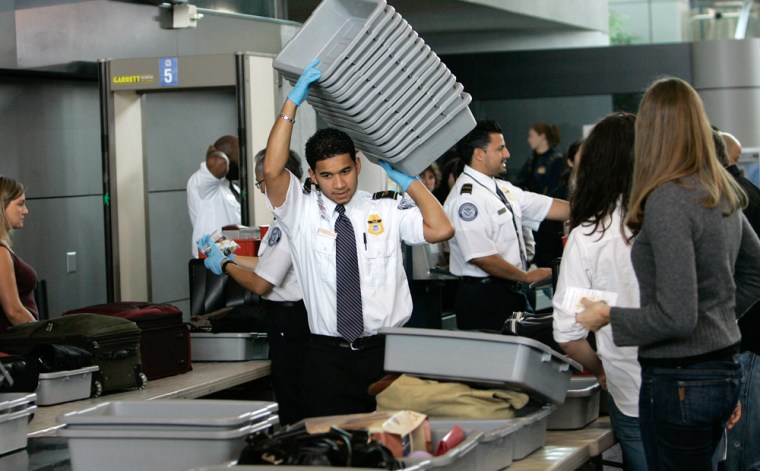Knitting needles, a couple of Christmas presents, and a half-cup of lukewarm coffee.
If you were tasked with the job of preventing terrorist attacks on airplanes, which would you let through security without a second glance?
Apparently, the correct answer is the knitting needles. And if a flight I took last week is any indication, that’s true even if they’re 10 inches long, as big around as a railroad spike and as pointy as a pair of bayonets.
How is it, I asked the needle-wielding woman across the aisle, that she could carry a pair of small spears onboard while I had to toss my last few ounces of coffee before passing through security? She just shrugged and said, “I don’t know. I guess they figure I’m not a terrorist.”
Well, neither am I (and neither, it seems, was that nice grandfatherly man who had to go through secondary screening because he had a few pre-wrapped presents). And while I understand the need for airport security, I sometimes wonder about the reasoning behind the regulations.
Lighters are banned, but safety matches (up to four books) are OK. A six-inch screwdriver is considered safe, but a six-ounce Yoplait is not. Unlike most liquids, baby formula or breast milk is allowed in any quantity — but only if a baby is actually present. And in the newest addition to the TSA’s list of prohibited items, snow globes (of any size) are now forbidden.
Is this any way to run an airport-security system? Are such seemingly random restrictions truly making us safer, or are they, as some critics suggest, simply “security theater,” designed to make us feel safe? And if screeners spend their time searching for snow globes and tubes of toothpaste, can they give truly dangerous items the attention they deserve?
Bombs, blades and penile pumps
It’s not an idle question. In the most recently publicized test of screening procedures (conducted at Newark Liberty International Airport last October), undercover TSA agents managed to smuggle fake guns and bombs past security in 20 of 22 attempts. One explosive device was apparently “hidden” beneath water bottles while another was missed during a secondary pat-down.
And that failure wasn’t an isolated incident. Previous tests in other airports have had similar or even worse results, and the sheer volume of passengers and bags passing through security these days doesn’t bode well for improvement any time soon.
(On the bright, or at least lighter, side, screeners have detected a dazzling array of potentially dangerous items, including chainsaws, ax heads and at least one, ahem, male-enhancement device that apparently resembled a grenade.)
Eye-rolling anecdotes aside, I don’t mean to mock airport security. It’s a fact of travel life and one that we’ll be dealing with as long as we use airplanes to get around. But it’s also a fact of life that evil people will always be able to sneak deadly materials onto airplanes if they want to badly enough. The current system is designed in part to add enough uncertainty to the screening process to give someone pause, but it may just prompt them to change their plan of attack.
In other words, the next airplane-based terror threat probably won’t have anything to do with liquids or gels — or lighters, shoes or box cutters, for that matter — but rather, something else previously considered safe. If that’s the case, I shudder to think what we’ll have to give up next.
Ban people, not objects?
The bigger problem, say critics, is that the focus on prohibiting banned objects is worse than inefficient — it’s misguided. Instead, they say, screeners should focus on people who display suspicious behavior, not potentially suspect items. In fact, TSA has been testing such a program since 2003 and is currently rolling it out in airports across the country.
The program, called Screening Passengers by Observation Techniques, or SPOT, employs “behavior detection officers” who are trained to scan travelers for behaviors and body language that signal unease or agitation. Profuse sweating, nervous tics, even seemingly excessive loitering can prompt a follow-up conversation and added scrutiny.
Sweating? Nervousness? Standing around? Doesn’t that pretty much define life in the terminal these days? The folks at TSA say SPOT-trained agents will be able to tell the difference between the normally nervous and the maliciously motivated, but don’t be surprised if you feel like you’re being watched the next time you fly.
Still, and despite concerns about training, tactics and the potential for racial profiling, SPOT seems like a step in the right direction. It’s not perfect, and it won’t replace metal detectors and secondary bag checks entirely. It may, however, prompt more effective use of those other screening techniques, which would certainly be an improvement.
And who knows, maybe someday soon, we may even be able to travel with our snow globes and scissors in hand, our regular toiletries in our carry-on bags and our shoes on our feet.
Rob Lovitt is a frequent contributor to MSNBC.com. If you have feedback for Rob, .
